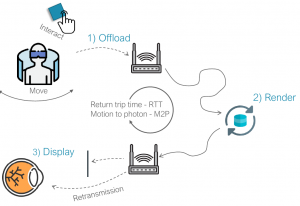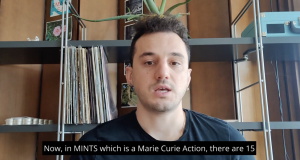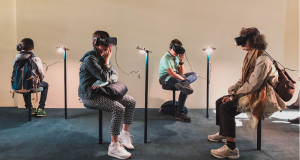Published on: Jun 25, 2021
Mankind has had to resort to online gatherings during the pandemic, as event venues, the hospitality sector, and even office spaces closed their doors to visitors. Whether partaking in a work related meeting, checking in on one’s loved ones, or enjoying a drink with friends in the evening, online is the place to be. However, voice and video calls do not always go to plan. Often sound and video are out of sync, a part of the stream suddenly goes missing, or there is a persistent time delay in communication. Through these experiences, even the most incurious have become acquainted with latency.
Who needs low-latency?
Defined as the time delay from the start of transmission till the arrival of the data at its destination, latency is a fundamental performance figure of any communication network. For example, a car on the highway asking for permission to overtake a lorry, considering that there are no other vehicles in their vicinity, perceives latency as the time from when it starts transmitting the inquiry till it receives an answer from the lorry. Since messages get exchanged in both directions, this is referred to as the round trip time (RTT) latency. If a traffic management system, residing in a nearby base station, issued the overtake command instead, then the time delay would be referred to as end to end (E2E) latency. Meaning the time elapsed between the base station relaying the command and the car interpreting it. Vehicle applications are not the only ones with stringent latency constraints. Industry 4.0 and extended reality (XR) also contribute their share of latency-sensitive applications. Table 1 summarizes several such applications and their latency constraints.
| Field | Use case | Latency (ms) | Type | Ref. |
| XR | AR/MR | <10 | RTT
and E2E |
[1, 2] |
| VR | <20 | [3, 4] | ||
| V2X | Cooperative driving | <10 | RTT | [1, 2, 5] |
| Remote driving and position sharing | E2E | |||
| Platooning | <50 | RTT | ||
| Collective Information sharing | <100 | E2E | ||
| Ind 4.0 | Cooperative robots | <1 | RTT | [6] |
| Process remote control and monitoring | <50 | E2E |
Table 1: Summary of application latency constraints
While low-latency messages often only bear critical information such as the position of a moving object, XR applications need to transfer entire video frames in only a few milliseconds. This encompasses the transmission of the video frame from an edge computing node to the XR device, as illustrated in Figure 1. Depending on the video quality and encoding standard, video frame size at the rendering machine may range from several Kilobytes to hundreds of Megabytes. The large video frame payloads then tend to get broken down into smaller transmission messages during their propagation through the transmitter’s network protocol stack. While being transmitted, they might be subject to varying channel conditions (resulting in varying signal qualities), provoking individual retransmissions if the received data is unrecognizable. Often they are also affected by preemption. For instance, a considerable drop in signal quality will trigger beam scanning, further delaying the transmission of any pending data. Recall that the receiving device still has to wait for the arrival of the entire payload before it can hand over a new video frame to the display component on the XR headset. The latency’s added stochastic behaviour manifests itself in the variable arrival times of video frames. This is also referred to as jitter, a phenomenon that takes a far larger toll on the perceived quality of experience (QoE). Consequently, the age of the received information fluctuates. As latency grows, the arrival of frames is no longer synchronised with the display refresh interval, potentially leading to dropped frames and overall QoE deterioration.

Figure 1: Illustration of RTT delays in XR applications. If there is no sensor feedback, there is only downlink from the rendering machine to the XR device; hence, RTT delays become E2E latency. Individual icons sourced from [7]
The future of low-latency communications
While 5G adds support for ultra-reliable low-latency communications, there is an abundance of other radio network technologies that are struggling to meet the requirements of low-latency applications. Moreover, the described use cases largely differ from one another when taking other QoS metrics into account, such as reliability and throughput. For example, XR headsets require multi-Gbps data rates, Industry 4.0 applications can not afford to lose more than 0.0001% of the transmitted data, and V2X communications need to support consistently high QoS levels for users traveling at several hundreds of kilometers per hour. However, they are all troubled by a common denominator – poor mmWave signal coverage due to propagation loss, low diffraction around objects, and a sparse multipath environment. The result is a higher error probability in the received data that may trigger data retransmission, generating more latency. Therefore, future research should focus on providing more stable mmWave data links that will indirectly reduce E2E time delays, while also improving other QoS parameters. The cornerstones for spatially diverse communications are already being laid as the sixth generation (6G) standard is starting to take shape.
If you were able to stick until the end and can’t wait for more content and you also want to know about us and our projects, you can always follow our social media channels.
References
[1] 3GPP, “Study on Communication for Automation in Vertical Domains,” [online], 2020. Available: https://portal.3gpp.org/desktopmodules/Specifications/SpecificationDetails.aspx?specificationId=3187
[2] M.A. Siddiqi, H. Yu and J. Joung, “5G Ultra-Reliable Low-Latency Communication Implementation Challenges and Operational Issues with IoT Devices,” MDPI Electronics, vol. 8, no. 9, p. 981, Sep. 2019.
[3] Oculus VR Inc., “Oculus VR Best practices guide,” [online], 2014. Available: https://brianschrank.com/vrgames/resources/OculusBestPractices.pdf
[4] T. Adame, M. Carrascosa and B. Bellalta, “Time-Sensitive Networking in IEEE 802.11be: On the Way to Low-latency WiFi 7,” [online], 2019. Available: https://arxiv.org/pdf/1912.06086v1.pdf
[5] A. Kanavos, D. Fragkos, and A. Kaloxylos, “V2X Communication over Cellular Networks: Capabilities and Challenges.” MDPI Telecom 2021, vol. 2, no. 1, pp. 1–26, Jan. 2021.
[6] ITU and 5G ACIA, “5G for Connected Industries and Automation,” [online], 2019. Available: https://5g-acia.org/wp-content/uploads/2021/04/WP_5G_for_Connected_Industries_and_Automation_Download_19.03.19.pdf
[7] Flaticon landing page. Available: https://www.flaticon.com/





